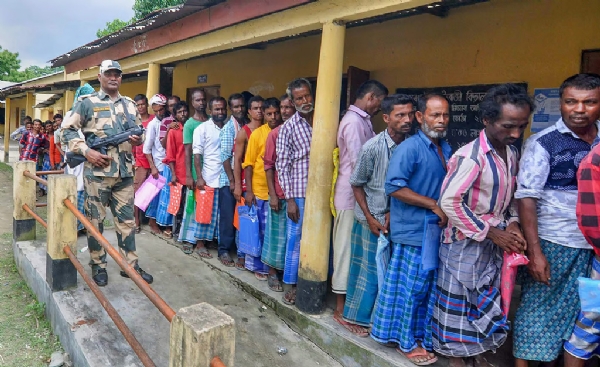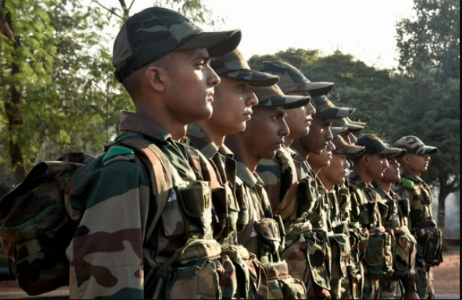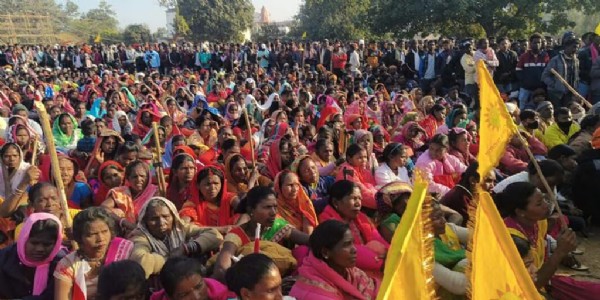Illegal Bangladeshi /Rohingya migration-Biggest threat to India's national security Part 1
When the BSF manages to apprehend illegal entrants, legal obstacles and hostile local populations—many of whom are Bangladeshi settlers—hinder their efforts.
Total Views | 335
Porous India-Bangladesh Border and Fencing Efforts
India shares a 4,096.7 km border with Bangladesh, distributed across several states:
Assam: 262 km
Tripura: 856 km
Mizoram: 318 km
Meghalaya: 443 km
West Bengal: 2,217 km

Barbed wire fencing has been installed along 3,180.653 km of this border, with the remaining 916.7 km expected to be completed by 2025.
Border patrolling, especially in riverine areas, presents significant challenges. The previous scheme of floating border posts has proven ineffective. Despite stringent measures, illegal immigration from Bangladesh continues unabated.
Magnitude of the Problem
Millions of illegal Bangladeshi migrants have entered various Indian states by exploiting the porous Indo-Bangladesh border. Organized gangs of agents facilitate this migration. Initially concentrated in West Bengal, Assam, and the northeastern states, they have now spread to 8-9 other states, including Maharashtra.
In Maharashtra, their numbers are estimated to be in the hundreds of thousands, with significant concentrations in cities like Mumbai, Navi Mumbai, Pune, Aurangabad, Bhiwandi, Malegaon, and coastal areas. These migrants are often employed in labor-intensive sectors such as construction, roadwork, and metro projects.
Many Bangladeshi migrants are now resorting to sea routes. They are reaching new states such as Odisha via boats, leading to a surge in illegal settlements across several districts, including Kendrapara, Nawarangpur, Malkangiri, Bhubaneswar, Puri, Chilika, Ganjam, Balasore, and Keonjhar.
Complicity of Local Administration
Instead of aiding the Border Security Force (BSF), local civil administrations are found supporting illegal migrants. In many cases, necessary documents are prepared even before migrants set foot on Indian soil. When the BSF manages to apprehend illegal entrants, legal obstacles and hostile local populations—many of whom are Bangladeshi settlers—hinder their efforts.
Role of Employers and Local Support
Some locals knowingly employ illegal migrants, driven by religious affiliations or vote-bank politics. This complicity enables migrants to integrate into local communities, making detection more challenging.
Continuing Infiltration Despite Security Measures
Despite the deployment of the Border Security Force illegal infiltration from Bangladesh into India continues unabated. CFrequent complaints regarding illegal infiltration have been reported, yet no strong deterrent actions have been taken. Additionally, allegations of cattle smuggling from India to Bangladesh have continued for a long time.
A recent viral video has raised fresh concerns about the effectiveness of border surveillance. The video, captured in Assam’s Dhubri district, shows common people opening border gates in the absence of BSF personnel, allowing unrestricted movement between the two countries. The ease with which tractors entered Indian territory from Bangladesh suggests a serious security lapse.
Challenges in Border Management
This incident is not an isolated case; rather, it highlights a systemic issue in border management. While the central government has reiterated its commitment to strengthening border security, the video reveals a stark contrast to those claims. The apparent lack of enforcement and supervision raises questions about the effectiveness of existing security protocols.
The Need for Stronger Measures
The latest revelations underscore the urgent need for enhanced border security measures, increased deployment of personnel, and stricter enforcement of border management protocols. Authorities must ensure that such security breaches do not continue unchecked, as they pose a serious threat to national security and territorial integrity.
Following major aspects will be covered in this article:-
- Accusations Against the BSF
- Encouragement of Infiltration by Bengal's State Government
- State Machinery’s Role: Not Just the BSF’s Responsibility
- Bangladeshi Infiltration and Demographic Shift in Jharkhand’s Tribal Belt & Countermeasures.
- Security Threats from Illegal Immigration
- Remedial Measures to Counter Demographic Invasion.
- Bangladeshi Infiltration in Various Indian States Factors Contributing to Spread:
- Remedial Measures to Counter Demographic Invasion In Hinterland
- Addressing Illegal Bangladeshi Migration in India-Few Recommendations
- Conclusion-Changing Tactics of Bangladeshi Infiltrators & Countering It
Mamata Banerjee Blames BSF for Infiltration from Bangladesh
( 2 January 2025)
Accusations Against the BSF
West Bengal Chief Minister Mamata Banerjee has accused the Border Security Force (BSF) of enabling infiltration from Bangladesh and committing atrocities against women. Speaking at an administrative meeting, Banerjee alleged that the BSF's actions were destabilizing West Bengal. Her remarks come ahead of the 2026 Assembly elections.
Her accusations follow Union Home Minister Amit Shah’s statement, where he cited infiltration from Bangladesh as a significant factor disrupting peace in West Bengal.
Banerjee’s Response to Infiltration Allegations
Rejecting claims that her party was complicit in allowing illegal infiltration, Banerjee shifted the blame onto the BSF. She stated:
"The BSF is allowing infiltration from different areas into Bengal while also torturing women. The TMC is not responsible for guarding the borders. The borders are under the BSF’s jurisdiction, so if someone accuses the TMC of permitting infiltration, I will point out that it is the BSF’s responsibility."
She also instructed the Director General of Police to investigate suspected infiltration points and pledged to send a strong letter to the central government addressing the issue.Banerjee criticized the BSF for allegedly facilitating criminal activities.
"We have no enmity, but criminals are being allowed into our state. They commit crimes here and then return across the border. The BSF is enabling this, " she asserted.
Investigations by India Today have revealed that porous stretches are frequently exploited for illegal activities, including human trafficking, cattle smuggling, and arms trade.
"Bengal a Nursery for Infiltration"
Responding sharply to Banerjee’s accusations, Union Minister Giriraj Singh blamed her government for deliberately allowing Bangladeshi infiltration for political gains.
"Most of the illegal infiltrators caught in India are from Bangladesh, and many of them have Bengal-based addresses. Mamata Didi is doing this for vote-bank politics, turning Bengal into a gateway for Bangladeshi Muslims and Rohingyas. Meanwhile, Hindus in Bangladesh continue to face atrocities, and the entire world is witnessing this," Singh remarked.
Encouragement of Infiltration by Bengal's State Government
Home Minister Amit Shah has been accusing the Mamata Banerjee government of promoting the illegal influx of Bangladeshi and Rohingya Muslims into West Bengal. Shah's comments, made at a Kolkata event on October 27, highlighted what he described as “state-sponsored infiltration.”
The Vote Bank Strategy and Demographic Shifts
The Banerjee administration allegedly facilitates the influx of Bangladeshi and Rohingya Muslims by providing citizenship documents, thereby securing a loyal vote bank. The influx has contributed to a significant rise in Bengal's Bangladeshi Muslim population over the years, growing at a pace far surpassing natural rates.
Population data reveal a dramatic increase in the Muslim population since 1951, with recent estimates suggesting Bangladeshi Muslims comprise around 31% of Bengal’s population. Such abnormal growth is closely linked to unchecked infiltration, which various political parties, including Congress and the Left Front, have leveraged to expand their influence. The TMC now appears to be following this trend, using the demographic shift to cement its political power.
State Machinery’s Role: Not Just the BSF’s Responsibility
Although the BSF’s mandate is to secure the Indo-Bangladesh border, guarding every inch of the extensive and varied terrain is challenging. Large stretches of the border are fenced, yet smugglers and traffickers frequently find ways to breach the fence or navigate riverine areas where fencing is impossible.
However, the steady flow of illegal migrants into Bengal owes much to a welcoming attitude from local authorities. Elected officials in border regions, aided by Bengal police, reportedly assist infiltrators in obtaining fake documents, such as birth and residency certificates. These documents enable illegal entrants to procure further identification like ration and voter ID cards, facilitated by lower-level government functionaries influenced by political interests. Consequently, infiltrators find refuge in Bengal not only due to border vulnerabilities but also due to a favourable state machinery.
All the Bangladeshi caught in Maharashtra had their documents made in West Bengal.
Comparisons with Assam and Tripura: Contrasting Outcomes
In contrast to Bengal, states like Assam and Tripura have actively curbed illegal migration through stringent enforcement. Both states' police forces, backed by BJP-led governments, have consistently intercepted Bangladeshi and Rohingya migrants. For example, in October alone, Assam and Tripura authorities, along with the Railway Protection Force (RPF), arrested over 300 illegal infiltrators. This outcome reflects directives from their state governments to proactively target illegal migration.
Since the BJP assumed power in Assam and Tripura, migration flows into these states have declined sharply.
The vigilance has made Bangladeshis and Rohingyas less inclined to enter these areas, as they are unable to obtain citizenship documents and face tighter scrutiny. Instead, many migrants seek refuge in Bengal, where they know they can secure a more accommodating environment.
By welcoming Bangladeshi and Rohingya Muslims and ensuring they receive necessary documents, the ruling party in Bengal has created conditions conducive to largescale illegal immigration, a situation that contrasts sharply with the tighter controls seen in Assam and Tripura.
--
Bharati Web






